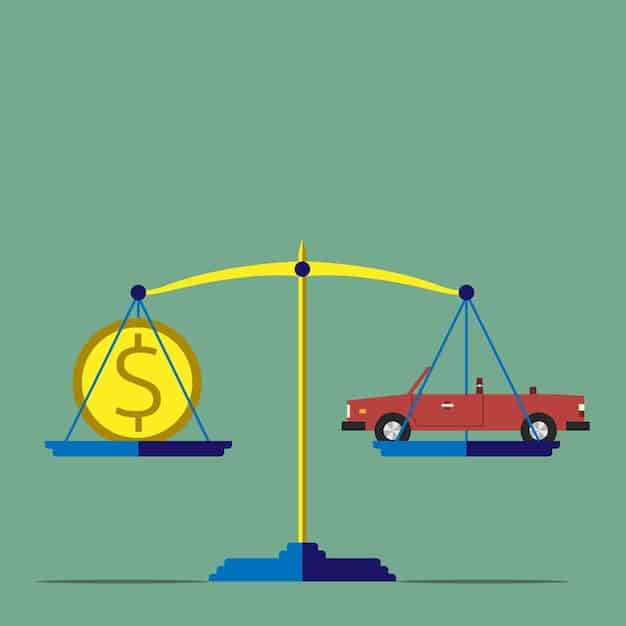Tax-Advantaged Accounts: HSA, IRA, and 401(k) Benefits Explained

Tax-advantaged accounts, including Health Savings Accounts (HSAs), Individual Retirement Accounts (IRAs), and 401(k)s, offer unique benefits for managing healthcare expenses and retirement savings while reducing your current tax liability, helping you grow your wealth more efficiently.
Navigating the world of finance can seem daunting, but understanding tax-advantaged accounts is a game-changer. Tax-advantaged accounts: HSA, IRA, and 401(k) benefits explained can empower you to make smarter financial decisions and secure your future.
Understanding Tax-Advantaged Accounts
Tax-advantaged accounts are investment or savings accounts that offer special tax benefits, encouraging individuals to save for specific purposes like healthcare, retirement, or education. These accounts can significantly reduce your overall tax burden while helping you build long-term wealth.
What Makes an Account Tax-Advantaged?
Tax advantages come in various forms. Some accounts offer tax-deductible contributions, meaning you can deduct the amount you contribute from your taxable income. Others offer tax-deferred growth, where your investments grow tax-free until you withdraw the money in retirement. Still others offer tax-free withdrawals, so long as you meet certain conditions.
Types of Tax Advantages
- Tax-deductible contributions: Reduce your current taxable income.
- Tax-deferred growth: Investments grow without being taxed until withdrawal.
- Tax-free withdrawals: No taxes are paid when you withdraw the money (if conditions are met).

Tax-advantaged accounts can significantly impact your financial strategy and long-term savings. It’s essential to understand the options available to make informed decisions.
Health Savings Accounts (HSAs)
Health Savings Accounts (HSAs) are designed to help individuals save for healthcare expenses. To be eligible for an HSA, you must be enrolled in a high-deductible health plan (HDHP). HSAs offer a triple tax advantage: tax-deductible contributions, tax-deferred growth, and tax-free withdrawals for qualified medical expenses.
Contribution Limits and Eligibility
Contribution limits for HSAs are set annually by the IRS. For 2023, the limits are $3,850 for individuals and $7,750 for families, with an additional $1,000 catch-up contribution for those age 55 and older. To be eligible, you must be enrolled in an HDHP and cannot be covered by any other health insurance plan.
Benefits of Using an HSA
- Triple tax advantage: Contributions are tax-deductible, earnings grow tax-deferred, and withdrawals for qualified medical expenses are tax-free.
- Portability: The account is yours, even if you change jobs or health plans.
- Investment options: Many HSAs allow you to invest your contributions, potentially growing your savings faster.
HSAs are an excellent tool for managing healthcare costs while enjoying significant tax benefits. Understanding the rules and leveraging the advantages can greatly improve your financial health.
Individual Retirement Accounts (IRAs)
Individual Retirement Accounts (IRAs) are retirement savings accounts that offer tax advantages. There are two main types of IRAs: Traditional IRAs and Roth IRAs. Knowing which one is best depends on your current and expected future income.
Traditional IRA: Benefits and Contribution Limits
Traditional IRAs offer tax-deductible contributions, and earnings grow tax-deferred. Contributions may be tax-deductible, depending on your income and whether you’re covered by a retirement plan at work. For 2023, the contribution limit is $6,500, with an additional $1,000 catch-up contribution for those age 50 and older.
With traditional IRAs, withdrawals in retirement are taxed as ordinary income, so the biggest benefit comes upfront when money comes directly out of your taxable income.
Roth IRA: Tax-Free Withdrawals
Roth IRAs offer tax-free withdrawals in retirement. Contributions are made with after-tax dollars, but your earnings and withdrawals are tax-free, provided certain conditions are met. The contribution limits are the same as for Traditional IRAs. Roth IRAs are useful if you anticipate your tax bracket will be higher in the future.
- Contribution Limits: Annual limits apply; consult IRS guidelines.
- Income Limits: Roth IRAs have income limits; higher earners may not be eligible.
- Withdrawal Rules: Generally, withdrawals before age 59 ½ are subject to a 10% penalty, with some exceptions.

Choosing between a Traditional IRA and a Roth IRA depends on your individual circumstances, tax bracket, and retirement goals. Understanding the differences can help you maximize your retirement savings.
401(k) Plans
A 401(k) is a U.S. retirement savings plan offered by employers to their employees. Contributions are often made via payroll deductions, and some employers offer matching contributions, making it a great opportunity for employees to accumulate assets for their retirement.
Traditional vs. Roth 401(k)
Like IRAs, 401(k) plans come in traditional and Roth versions. Traditional 401(k) contributions are tax-deductible, reducing your current taxable income, but withdrawals in retirement are taxed.
Roth 401(k) contributions are made with after-tax dollars, but withdrawals in retirement are tax-free. The choice depends on your current and expected future tax bracket.
Contribution Limits and Employer Matching
Contribution limits for 401(k) plans are significantly higher than for IRAs. For 2023, the employee contribution limit is $22,500, with an additional $7,500 catch-up contribution for those age 50 and older. Employer matching contributions can significantly boost your retirement savings.
- Contribution Limits: Higher than IRAs, set annually by the IRS.
- Employer Match: Take advantage of employer matching contributions to maximize savings.
- Investment Options: Typically offer a range of investment options, including mutual funds and target-date funds.
Participating in a 401(k) plan is an effective way to save for retirement, especially if your employer offers matching contributions. Understanding the plan’s features and investment options can help you make the most of this benefit.
Comparing HSA, IRA, and 401(k)
HSAs, IRAs, and 401(k)s each cater to distinct needs and financial goals. Understanding their key differences is crucial for effective financial planning. HSAs are ideal for healthcare savings, while IRAs and 401(k)s primarily target retirement savings.
Key Differences at a Glance
HSAs offer a triple tax advantage, but eligibility is tied to high-deductible health plans. IRAs offer flexibility with Traditional and Roth options, catering to different tax strategies. 401(k)s, typically employer-sponsored, often come with employer matching and higher contribution limits.
Which Account is Right for You?
The best account for you depends on your individual circumstances, financial goals, and risk tolerance. Consider factors such as your healthcare needs, retirement timeline, current and expected future income, and employer benefits. Some people will take advantage of all the options.
Diversifying your tax-advantaged accounts can provide a well-rounded approach to saving for various financial needs. Consult with a financial advisor for personalized guidance tailored to your specific situation.
Maximizing Tax Benefits
To make the most of tax-advantaged accounts, understanding strategies to maximize their benefits is essential. This includes optimizing contributions, managing investments, and planning withdrawals.
Contribution Strategies
Contributing the maximum allowed amount each year is an effective way to build long-term wealth. Even if you can’t max out your contributions, aim to contribute as much as you can afford. Small, consistent contributions can add up over time. Automating tax advantages savings is a great way to get started investing.
Investment Management
Diversifying your investments within your tax-advantaged accounts can help reduce risk and maximize returns. Consider your risk, tolerance, and time horizon when choosing investments. Mutual funds, ETFs, and target-date funds are common investment options.
Review and rebalance your portfolio regularly to ensure it aligns with your financial goals and risk tolerance.
Withdrawal Planning
Understanding the withdrawal rules for each type of account is crucial to avoid penalties and maximize tax benefits. Plan your withdrawals carefully to minimize taxes and ensure your savings last throughout retirement.
Strategic planning and consistent contributions are key to maximizing the tax benefits of these accounts.
| Key Aspect | Brief Description |
|---|---|
| ⚕️ HSA Benefits | Triple tax advantage for healthcare savings if you have a high-deductible healthcare plan. |
| 💸 IRA Types | Traditional IRAs offer tax-deductible contributions, while Roth IRAs offer tax-free withdrawals. |
| 💼 401(k) Employer Match | Maximize savings by contributing enough to get the full employer match – potentially doubling your savings. |
| 📈 Investment Strategy | Diversifying your investments helps balance risk and growth potential within these accounts. |
Frequently Asked Questions (FAQs)
▼
A tax-advantaged account is a financial account that offers tax benefits such as tax-deductible contributions, tax-deferred growth, or tax-free withdrawals.
▼
To be eligible for an HSA, you must be enrolled in a high-deductible health plan (HDHP) and not be covered by any other health insurance.
▼
Traditional IRA contributions may be tax-deductible, and earnings grow tax-deferred. Roth IRA contributions are made with after-tax dollars, but withdrawals are tax-free.
▼
Employer matching is when your employer contributes a certain amount to your 401(k) account, typically a percentage of your contributions, up to a certain limit.
▼
Maximize tax benefits by contributing the maximum allowed amount each year, diversifying investments within the accounts, and carefully planning withdrawals to minimize taxes.
Conclusion
Understanding and utilizing tax-advantaged accounts: HSA, IRA, and 401(k) benefits explained can significantly improve your financial health and security, whether you’re saving for healthcare or retirement. By making informed decisions and taking full advantage of these accounts, you can build a solid foundation for your financial future.





